
About human proportions calculator
This tool provides a simple and fast way to know the proportions of an ideal and realistic human figure. It proposes an easy way for an artist to understand what the human body proportion sizes are.
Butt bones include the Bony pelvis and the upper parts of the Femurs. When we think of the hips and butt, the first things that come to mind are the muscles and subcutaneous fat, and we might sometimes even forget about the skeleton underneath.

Butt bone bony landmarks are essential for artists navigating the region of the hips and butt. Without these landmarks, it’s just an unstructured mess where it’s extremely difficult to find and place muscle origins and insertions correctly.

Butt bones – the Bony pelvis and Femurs – hold three pairs of bony landmarks of the butt.
In addition to that, the skeletal differences between males and females affect the overall body proportions influencing the hip width, waist-to-hip ratio, torso length, leg angle, etc.
In this blog, we’ll review the butt bones and the bony landmarks of the hips and butt, look at the differences between the male and female bony pelvis and highlight the resulting differences in body proportions.
If you’re interested in the muscles and fat of the butt, be sure to check out the next blog on butt and hips anatomy.
The bony landmarks of the butt are located on the butt bones – the Ilium of the Bony Pelvis and the Femur. It’s important to know them because all the major muscles of the butt originate from the Ilium and insert in the Femur and the Iliotibial band.

Bony landmarks of the butt include the ASIS, PSIS, and Greater trochanter.
Understanding the underlying skeletal structure of the pelvis will ensure that you put the muscles in the right places and construct an overall realistic butt and hips.
These landmarks help to achieve accurate proportions, capture the nuances of pelvic tilt and rotation, and convey a sense of balance and stability in the representation of the human figure.
The bony landmarks of the pelvis are all located on the Iliac Crest, which is the superior border of the Ilium. The anterior extremity of the Iliac crest is called the Anterior Superior Iliac Spine (ASIS), while its posterior extremity is the Posterior Superior Iliac Spine (PSIS) – these are the two pairs of the bony landmarks of the pelvis.
ASIS is a great bony landmark of the pelvis for establishing accurate proportions of the whole figure and also for determining the tilt, rotation and alignment of the pelvis.

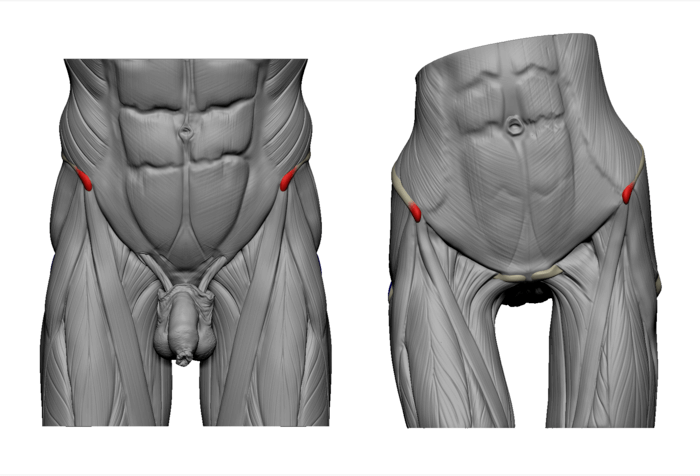
The male (left) and female (right) skeleton and ecorche with ASIS marked in red.
ASIS is where the Tensor Fasciae Latae muscle originates, and knowing this bony landmark will help you with muscle placement.

Male and female realistic anatomy with ASIS marked in red.
PSIS is the bony landmark of the pelvis marking the posterior extremity of the Iliac crest. PSIS are visible as two dimples right above the butt. Both ASIS and PSIS are pairs of pelvis bony landmarks, which can help you emphasize the body type of your figure. For example, make ASIS and PSIS visible if a person is more slender.
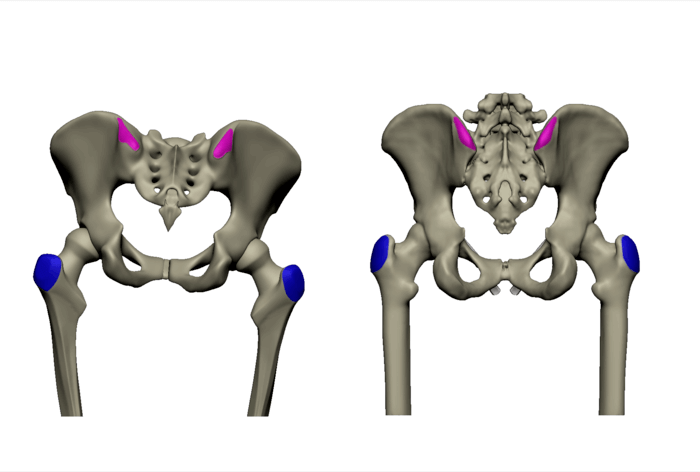

The female (left) and male (right) skeleton and ecorche with PSIS marked in pink and the Greater trochanter marked in blue.
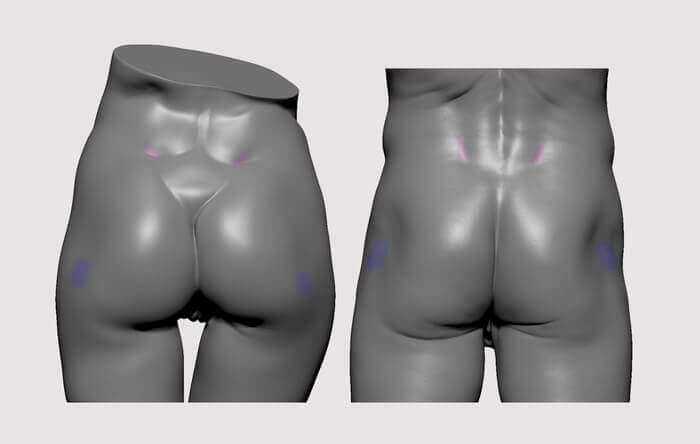
The female (left) and male (right) realistic anatomy with PSIS marked in pink and the Greater trochanter marked in blue.
The sacral triangle is the region found between the two PSIS and the Coccyx (tailbone), which is located where the butt crease begins. The sacral triangle provides a visual framework for establishing the correct angles and proportions when drawing or sculpting the hips and butt.
The bony landmarks of the Femur are the third pair of bony landmarks found on the hips and butt: the Greater trochanter. The Greater trochanter is a prominent bony landmark, which is also the widest part of the hips.
The Greater trochanter is often visible in the surface forms of the male butt, yet it can be less visible if a person is bulkier.

The female and male ecorche with the Greater trochanter marked in blue and PSIS marked in pink.
This bony landmark is less visible in the surface forms of the female butt because it’s covered by subcutaneous fat. However, it still influences the surface forms pushing on the skin and fat from underneath.

The Greater trochanter is a bony landmark of the Femur and the widest part of the hips.
Picture taken from our ArtStation.
The male and female pelvis have several differences, primarily due to the reproductive and physiological functions that they serve. As artists, we’re just interested in the differences in the general shape which affect the surface forms.
The female pelvis has a wider and shallower shape than the male pelvis. Its pelvic inlet is wider and more oval-shaped, the pelvic cavity is more spacious, and the subpubic angle is also wider than that of a male. This difference allows for the passage of the baby during childbirth.

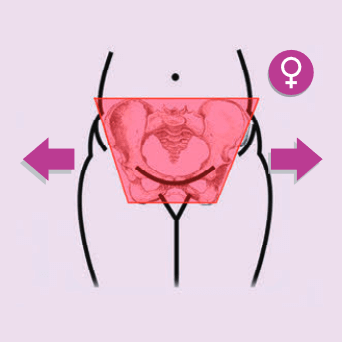
The male pelvis is narrower and deeper, while the female pelvis is wider and shallower.
The male and female body proportions differ a lot, and the pelvic shape plays a significant role in determining the differences in hip width, waistline height, waist-to-hip ratio, torso length, and even the leg angle.
different bony pelvis
=
different overall body proportions
The hip width differs in males and females: the wider and shallower shape of the female pelvis contributes to the characteristic wider hips seen in women. This hip width results from the greater distance between the two pelvic bones, known as the biiliac breadth. In contrast, the narrower male pelvis leads to relatively narrower hips.

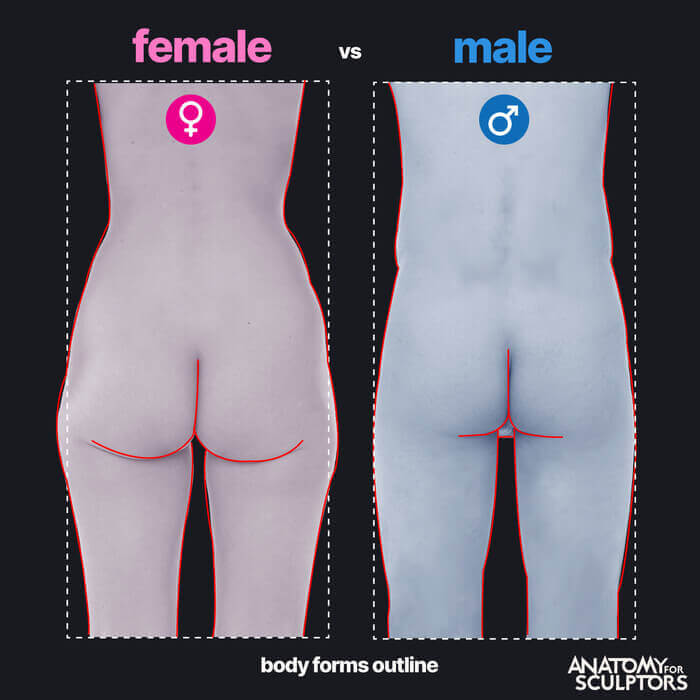
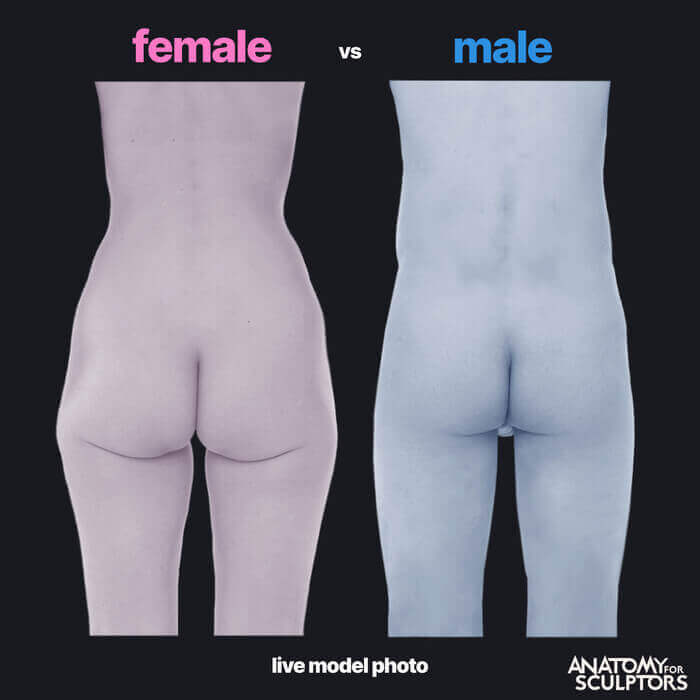
The differing pelvic shape in males and females determines that overall body proportions between males and females are different. Pictures taken from our ArtStation.
In females, the waistline is positioned higher due to the wider hips and the broader pelvic structure, which create a more pronounced curvature. Males typically have a lower waistline due to their narrower pelvis and less pronounced hip curvature.

The waist-to-hip ratio is a measure of the circumference of the waist compared to the hips. The waist-to-hip ratio is measured by dividing the waist size by the hip size.
Women tend to have a lower waist-to-hip ratio due to their wider hips. This ratio is considered an important physical feature in classical art, where it’s associated with attractiveness and fertility.
The torso length is different between the sexes: the narrow pelvis allows for a longer torso in males compared to females. This difference in torso length contributes to the overall body proportions and silhouette.
The leg angle is influenced by the wider female pelvis, which increases the distance between the Greater trochanters and thus influences the angle at which the Femurs connect to the hip joint.
This angle, known as the Q angle, tends to be wider in females, affecting the leg’s alignment and making the knees slightly inwardly angled.
Females tend to have a slightly greater anterior pelvic tilt compared to males. Anterior pelvic tilt refers to the forward rotation of the pelvis, where the front of the pelvis tilts downward, and the back of the pelvis tilts upward.
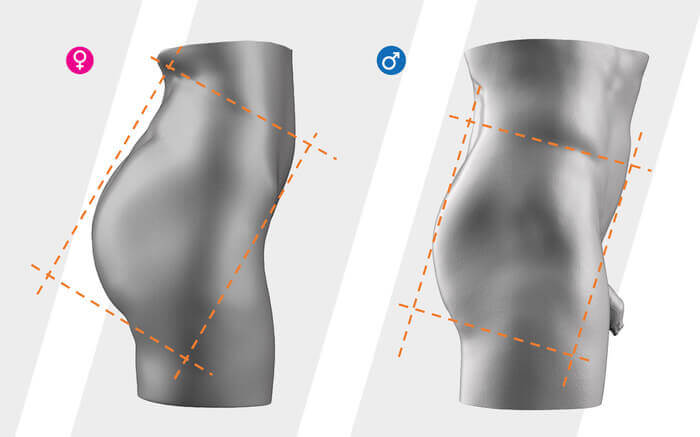
Female and male pelvic tilt difference.
Also, the angle of the Sacrum and Coccyx tends to be wider for females when compared to males. This “tail” part is more open for females, allowing for greater flexibility and movement during childbirth.
Butts are not wider than hips
We already talked in the introduction about humans having unique butts abundant with fat – no other creature in the animal kingdom has this. Yet, although our butts are big, we sometimes over-exaggerate their size.

Horizontal cross-sections of the male and female pelvis.
You can create big butts, but always make sure that the hips are wider than the butt. As seen in the male and female pelvis cross-sections in the picture, the butt is never wider or equally wide with the hips, and it is always more narrow.
This covers the bony landmarks and proportions of the butt. However, there’s still plenty to learn about the muscles and fat of the butt. We explore that in the next blog!
Be the first to get news about our upcoming discounts, books, tools, articles and more! No spam, just the good stuff.

This tool provides a simple and fast way to know the proportions of an ideal and realistic human figure. It proposes an easy way for an artist to understand what the human body proportion sizes are.

This is a story of a static figure becoming a powerful demonstration of the link between muscle and motion.
Shop